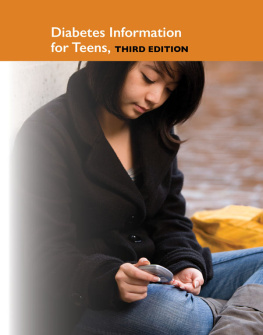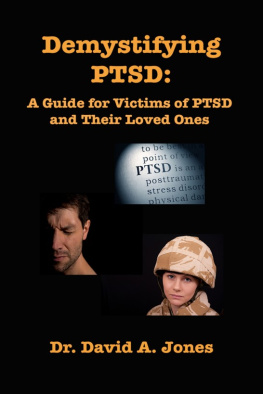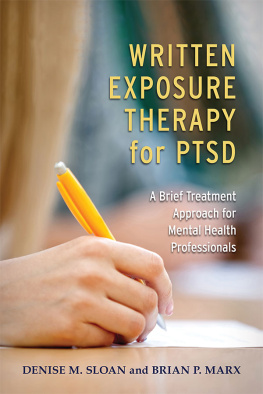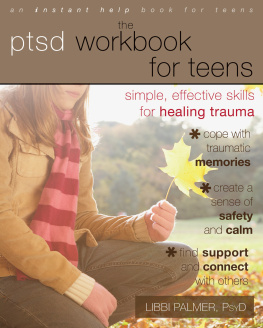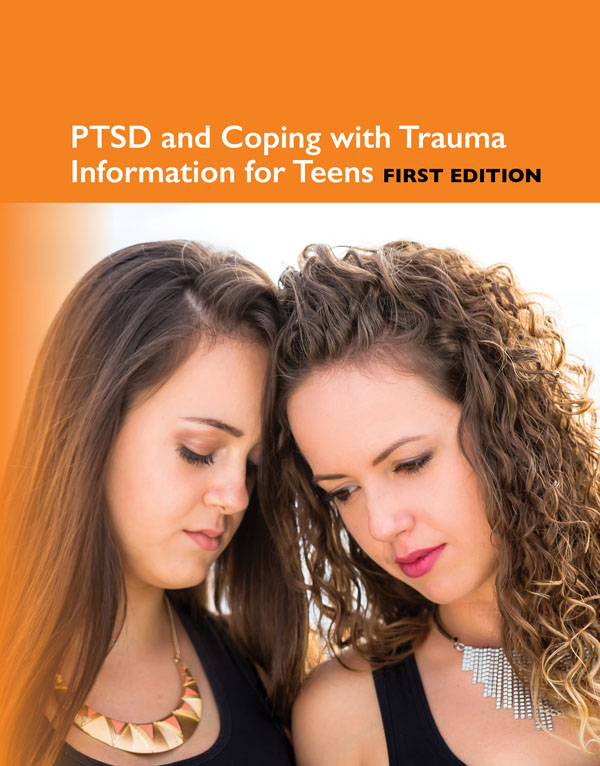Teen Health Series
PTSD and Coping with Trauma Information for Teens, First Edition
Teen Health Series
PTSD and Coping with Trauma Information for Teens, First Edition
Health Tips about the Symptoms, Diagnosis, and Treatment of PTSD
Including Facts about the Types of Trauma, Impact and Responses of PTSD, Populations at Risk, Co-occurring Conditions with PTSD, and Self-Help Strategies

615 Griswold St., Ste. 520
Detroit, MI 48226
Bibliographic Note
Because this page cannot legibly accommodate all the copyright notices, the Bibliographic Note portion of the Preface constitutes an extension of the copyright notice.
* * *
OMNIGRAPHICS
Angela L. Williams, Managing Editor
* * *
Copyright 2020 Omnigraphics
ISBN 978-0-7808-1768-5
E-ISBN 978-0-7808-1773-9
Library of Congress Cataloging-in-Publication Data
Names: Williams, Angela, 1963- editor.
Title: PTSD and coping with trauma information for teens / edited by Angela L. Williams.
Identifiers: LCCN 2019036517 (print) | LCCN 2019036518 (ebook) | ISBN 9780780817739 (ebook) | ISBN 9780780817685 (library binding) | ISBN 9780780817685_q(library binding) | ISBN 9780780817739_q(ebook)
Subjects: LCSH: Post-traumatic stress disorder in adolescence--Juvenile literature. | Post-traumatic stress disorder in adolescence--Diagnosis--Juvenile literature. | Post-traumatic stress disorder in adolescence--Treatment--Juvenile literature.
Classification: LCC RJ506.P55 (ebook) | LCC RJ506.P55 P87 2019 (print) | DDC 616.85/2100835--dc23
LC record available at https://lccn.loc.gov/2019036517
Electronic or mechanical reproduction, including photography, recording, or any other information storage and retrieval system for the purpose of resale is strictly prohibited without permission in writing from the publisher.
The information in this publication was compiled from the sources cited and from other sources considered reliable. While every possible effort has been made to ensure reliability, the publisher will not assume liability for damages caused by inaccuracies in the data, and makes no warranty, express or implied, on the accuracy of the information contained herein.

This book is printed on acid-free paper meeting the ANSI Z39.48 Standard. The infinity symbol that appears above indicates that the paper in this book meets that standard.
Printed in the United States
Preface
About This Book
Posttraumatic stress disorder (PTSD) is a mental illness that is developed after any traumatic event, such as war, rape, childhood abuse, accident, natural disaster, personal tragedy, or violence. Based on diagnostic interview data from the National Comorbidity Survey Adolescent Supplement (NCS-A), it is estimated that 5 percent of adolescents have had PTSD and 1.5 percent have had a severe impairment. It was found that the prevalence of PTSD was higher in females (8%) than in males (2.3%) among adolescents. Hence, expert guidance on how to best cope with trauma and the steps that one should take to overcome PTSD is necessary.
PTSD and Coping with Trauma Information for Teens, First Edition provides an overview of PTSD and its causes. It describes the brain and mental health. This book examines the prevalence of PTSD in teens and the populations at risk of PTSD. Information about different types of traumaadverse experiences, childhood abuse, physical abuse, sexual abuse, emotional, and psychological abuseis provided, including the impact of PTSD and recovery. The symptoms and co-occurring conditions of PTSD, along with its treatment, are also covered in this book. A directory of resources provides additional help for people who have undergone trauma and PTSD.
How to Use This Book
This book is divided into parts and chapters. Parts focus on broad areas of interest; chapters are devoted to single topics within a part.
describes PTSD and its causes. The brain and mental-health along with information about trauma are included, and the prevalence of PTSD in children and adolescents is also covered.
discusses the different types of trauma, such as childhood abuse, emotional and psychological abuse, sibling abuse, and sexual abuse, including child pornography, teen dating violence, and cyberbullying.
provides information about trauma reminders, anniversaries, and triggers. It explains the effects of PTSD on family, in addition to recovery from rape and sexual trauma.
discusses the populations at risk of developing PTSD, such as homeless youth, LGBTQ+ teens, and children and teens of military veteran families, along with substance use and the risk.
provides information about the symptoms of PTSD. It also elaborates on chronic pain, sleep disorders, and anger associated with PTSD.
explains the diagnosis and treatment of PTSD. Therapies such as psychotherapy, play therapy, and trauma-focused cognitive behavioral therapy are discussed. It also provides information about the medications prescribed to treat PTSD besides self-help strategies.
includes a directory of organizations to provide more details to help people who have undergone trauma and PTSD.
Bibliographic Note
This volume contains documents and excerpts from publications issued by the following U.S. government agencies: Centers for Disease Control and Prevention (CDC); Child Welfare Information Gateway; Eunice Kennedy Shriver National Institute of Child Health and Human Development (NICHD); National Cancer Institute (NCI); National Center for Posttraumatic Stress Disorder (NCPTSD); National Institute of Justice (NIJ); National Institute of Mental Health (NIMH); National Institute of Neurological Disorders and Stroke (NINDS); Office of Disease Prevention and Health Promotion (ODPHP); Office of Juvenile Justice and Delinquency Prevention (OJJDP); Office of the Assistant Secretary for Planning and Evaluation (ASPE); Office on Womens Health (OWH); Substance Abuse and Mental Health Services Administration (SAMHSA); U.S. Department of Education (ED); U.S. Department of Health and Human Services (HHS); U.S. Department of Justice (DOJ); U.S. Department of State (DOS); U.S. Department of Veterans Affairs (VA); and Youth.gov.
It may also contain original material produced by Omnigraphics and reviewed by medical consultants.
The photograph on the front cover is Dobo Kristian.
Medical Review
Omnigraphics contracts with a team of qualified, senior medical professionals who serve as medical consultants for the Teen Health Series. As necessary, medical consultants review reprinted and originally written material for currency and accuracy. Citations including the phrase Reviewed (month, year) indicate material reviewed by this team. Medical consultation services are provided to the Teen Health Series editors by:
Dr. Vijayalakshmi, MBBS, DGO, MD
Dr. Senthil Selvan, MBBS, DCH, MD
Dr. K. Sivanandham, MBBS, DCH, MS (Research), PhD
About The Teen Health Series
At the request of librarians serving todays young adults, the Teen Health Series was developed as a specially focused set of volumes within Omnigraphics Health Reference Series. Each volume deals comprehensively with a topic selected according to the needs and interests of people in middle school and high school. Teens seeking preventive guidance, information about disease warning signs, medical statistics, and risk factors for health problems will find answers to their questions in the


